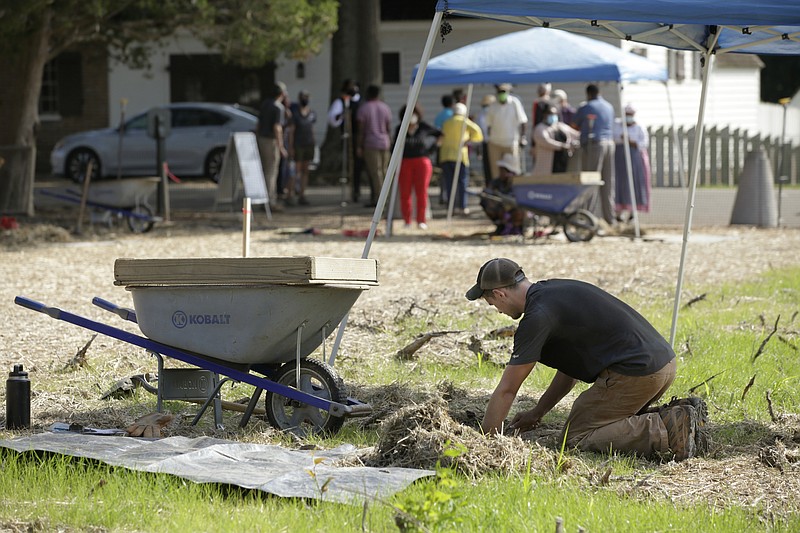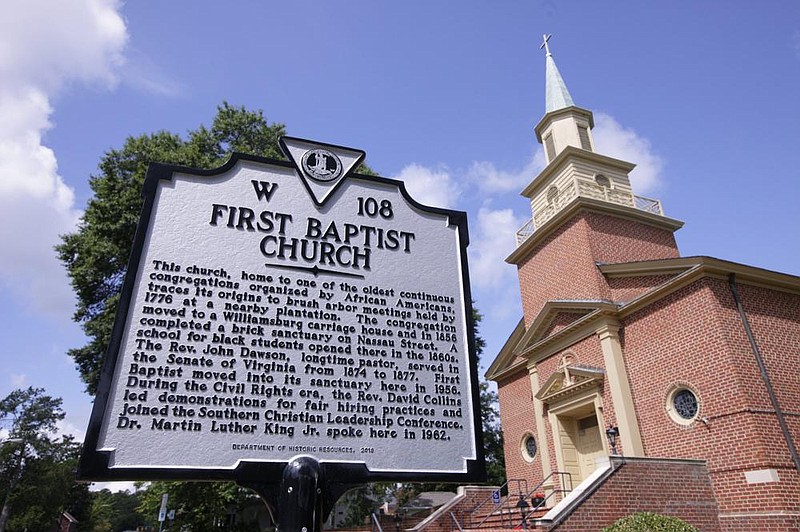WILLIAMSBURG, Va. -- The earth where Deshondra Dandridge was digging with her pick and trowel was packed hard and filled with stones where she knelt, searching for the bones of the old church.
Buried here in the orange clay of a former parking lot on Nassau Street are the remains of a vanished history -- the story of a Black congregation that didn't fit the Williamsburg narrative, whose people once worshipped and could be buried on this spot and whose roots are as old as those of the United States.
Dandridge and other archaeologists from Colonial Williamsburg last week began excavating the site of the old First Baptist Church, one of the oldest such churches in the country, which had buildings there in 1856, though perhaps as early as 1818, and was organized in 1776.
The 1856 church -- whose bell was used to dedicate the National Museum of African American History and Culture in Washington four years ago -- was torn down in the 1950s. But its foundation and that of two earlier structures, one possibly a privy, have been detected underground.
It is the earliest Black church in Williamsburg, experts said.
Oral tradition holds that the site may also contain the remains of past church members.
TO VOICE PRIDE, DISMAY
As the archaeologists began to dig on a warm morning earlier this month and the cicadas droned in the trees, members of Williamsburg's descendant First Baptist Church gathered to watch, to voice pride in their forebears and dismay that recognition has taken so long.
"There's a noticeable absence of the story of early African Americans in Williamsburg," said Connie Matthews Harshaw, president of the church's Let Freedom Ring Foundation.
Those who re-created the quaint Colonial attraction in the early and mid-1900s "basically erased everything that has to do with African Americans," she said. "It's a blank canvas."
During the entrenched racial segregation of the time, the story of a post-Colonial Black church did not fit the Williamsburg narrative, she said. A plaque was placed at the site in 1983.
But with this project, Colonial Williamsburg has "come full circle," she said. "I am just overwhelmed with joy. Weeping may last for a night, but there's joy in the morning. This is the morning."
"If they don't find one thing, the fact that [Colonial Williamsburg] acknowledged that we were here" is gratifying, she said. "But they're going to find something."
The Rev. Dr. Reginald Davis, senior pastor of First Baptist Church, said, "There are a lot of things ... about Black history that have either been covered up or shoved aside due to white supremacy."
ATTENDED THE OLD CHURCH
Dennis Gardner, 85, was born two blocks from the site. He had attended the old church "since I was like 6 years old, following my mom and dad," until it was sold, he said. "So I've been here a long time."
"Our side of the history of Williamsburg has not been told," he said.
The dig is expected to last about seven weeks.
"I'm just surprised the work had never been done before," Cliff Fleet, the Colonial Williamsburg Foundation's new president, said as he watched. "I'm surprised but I'm not surprised... . It's a story that needs to be told. And more people need to know it."
According to the congregation's tradition, enslaved and free Black people began meeting secretly in the woods to pray and listen to a minister named Moses, and later to an enslaved tavern worker and preacher named Gowan Pamphlet.
When Pamphlet, a Baptist, was ordained in 1772, he was the "only ordained Black preacher of any denomination in the country," according to Colonial Williamsburg.
And it was perhaps around that time that he began to lead meetings of the rural Black congregation outside town.
Williamsburg was the capital of Virginia from 1699 to 1780, and by 1775 more than half of its 1,880 residents were Black, most of them enslaved, according to historian Linda Rowe.
SUSPICIONS OF REVOLT
The church congregants had to meet in remote locales outdoors. It was dangerous for Black people to gather in numbers anywhere, for fear of arousing white suspicions of revolt.
Moses, the original preacher, was regularly whipped for holding religious meetings, Rowe wrote.
Pamphlet's enslaver, Jane Vobe, ran the King's Arms Tavern on Duke of Gloucester Street, across from the Raleigh Tavern, a popular venue for auctions of enslaved people, Rowe wrote in the Virginia Magazine of History and Biography.
Pamphlet's congregation grew anyhow, to as many as 500 by 1791, Rowe wrote.
And church tradition has it that a local white businessman, Jesse Cole, while walking his lands one day, came upon the congregation meeting and singing in an outdoor shelter made of tree limbs and underbrush.
Moved by the scene, he offered them a carriage house he owned on Nassau Street, according to Rowe.
At that point, the record becomes cloudy.
In 1818, there is a reference to a "Baptist meeting house" on the spot, according to the project's research. "It is unclear what this building looked like or how long it had been standing on the lot by 1818," researchers wrote.
Further mention came in 1834, when a tornado tore through Williamsburg and a Norfolk newspaper reported that the "colored people's meeting house" was blown down.
In 1855, a stately new brick church was built with a steeple and palladian windows.
The church housed a school for Black students in the 1860s. It survived a Civil War battle in 1862 that killed and wounded thousands of men, and filled the town with injured soldiers.
DAWN OF CIVIL RIGHTS
It served its members through the end of slavery, the eras of Reconstruction, Jim Crow racial oppression, segregation and the dawn of the civil rights movement.
The church shows up on a 1921 insurance map labeled "Baptist Church (Colored.)" The map notes that it was heated with "stoves" and illuminated with "lamps."
It was "hot as blazes in the summer," and cold in the winter, remembers Vernon Ross, who was baptized there in 1939. It had a pump organ, a choir, and on Sundays "you could hear the singing all over that end of town," he said in a recent interview.
In 1953, the researchers wrote, when the church planned to build an adjacent annex, a member of the congregation, "Sister Epps (Most likely Mrs. Fannie Epps)," said her great-grandfather was buried where the annex was supposed to go.
That raised the "very real possibility that congregation members have been buried on this property, though any grave markers that they may have erected are long-since removed," the research report said.
The church agreed to commemorate Epps's great-grandfather and started the annex but never finished it. The archaeologists have found what may be the annex foundation, and thus the possible location of the graves.
TORN DOWN IN 1955
Colonial Williamsburg subsequently bought the church and tore the old building down in 1955. The site was paved over in 1965. A new church funded by the sale -- First Baptist Church -- was built about eight blocks away in 1956.
After the old church was torn down, a limited archaeological dig was conducted in 1957, Jack Gary, Colonial Williamsburg's director of archaeology, said this month. Results were modest, he said.
Since then, aside from the former parking lot, the site has been undisturbed. "Nothing else has been on the lot," he said. "No one has lived here. So any artifacts we find, even if they're jumbled up, they have to be associated with the church.
"Which is really cool," he said.
Care will be used if a grave is found.
"We're looking for the top of the grave," he said. "As soon as we see that, and outline it, that's it, we stop. We have no intention of going down to human remains. The [descendants] of the people buried here are still in our community."
"They should have some say in what happens with these graves," he said. "We want to be able to find them, so that we can protect them."
If the community wanted an examination of the remains, "we would partner with a biological anthropologist," he said. "We would excavate down to the remains. We would make sure that everything is closed off."
The anthropologist could then study them, and possibly remove them for laboratory examination, he said.
"But we wouldn't do it without the consent of the community," he said. "This is their project."



